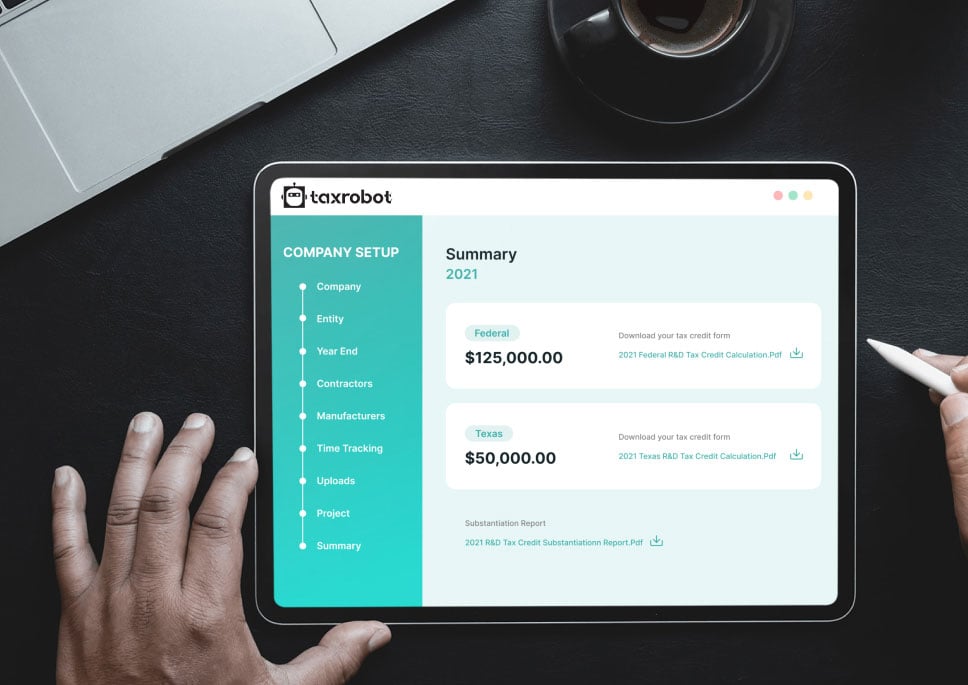Vermont R&D Tax Credit
With Tax Robot, Vermont R&D Tax Credit becomes more than a benefit—it becomes a catalyst for your business growth. Unleashing the incredible, simplifying the complex. This is not just tax planning; it’s financial evolution.
Maximize your State Credits today!
Put the R&D tax credit process on autopilot.
Trusted By:








Vermont R&D Tax Credit
Discover your eligibility for Vermont R&D tax credits and supercharge your enterprise.
Maximize Your Vermont R&D Tax Credits with TaxRobot's Expertise
In the competitive landscape of business innovation, Vermont’s R&D Tax Credit serves as a critical financial catalyst.
This state-specific incentive is not just a tax formality; it’s an opportunity for businesses to reinvest in their growth and technological advancement.
By leveraging federal section 41 rules, the credit offers a robust 27% on qualified R&D expenses incurred within Vermont.
Whether you’re a burgeoning startup or an established enterprise, this credit can significantly offset your R&D costs, accelerating your market leadership path.
With TaxRobot’s streamlined solutions, claiming this valuable credit has never been easier.
Key Features of Vermont’s R&D Tax Credit
Navigating the intricacies of tax credits can be daunting. Still, Vermont’s R&D Tax Credit is designed with simplicity and efficacy.
Eligibility is broad, encompassing various industries and business structures—from C-Corporations to LLCs. The credit calculation is straightforward, offering a substantial 27% of your federal R&D tax credit for qualified expenses in the state.
Its flexibility sets this credit apart; unused credit can be carried forward for up to a decade. Moreover, it applies to both personal income tax and business/corporate income tax, making it a versatile tool for financial planning.
With TaxRobot, you can effortlessly unlock these benefits, ensuring you don’t leave money on the table.
How TaxRobot Simplifies the Vermont R&D Tax Credit Process
In the realm of R&D tax credits, efficiency is paramount. TaxRobot revolutionizes this process through its AI-powered platform, turning what could be a labyrinthine task into a streamlined experience.
Our three-step process is elegantly simple:
- Provide your business information.
- Link your existing systems to our platform.
- Sit back as TaxRobot’s algorithms work tirelessly to maximize your refund.
By reducing the time and complexity traditionally associated with claiming R&D tax credits, TaxRobot empowers you to focus on what truly matters—innovating and growing your business.
Why Choose TaxRobot for Your Vermont R&D Tax Credit
Regarding R&D tax credits, expertise, and automation converge at TaxRobot. Our seasoned team of tax experts has a proven track record of securing millions in tax credits for our clients.
But we don’t stop at expertise; our AI-driven platform offers unparalleled audit support and value-based pricing. The result? Bigger refunds, audit-proof documentation, and peace of mind.
With TaxRobot, you’re not just claiming a tax credit but investing in a smarter, more efficient future for your business. Choose TaxRobot and experience the gold standard in R&D tax credit analysis.
FAQs: Vermont R&D Tax Credit
What percentage of credit does Vermont offer for R&D expenses?
Vermont offers a 27% tax credit on qualified R&D expenses.
Is the Vermont R&D Tax Credit refundable?
The credit is not refundable but can be carried forward for up to 10 years.
What types of businesses are eligible for this credit?
C-corporations, S-corporations, LLCs, and Partnerships are all eligible.
How is the credit calculated?
The credit is based on federal section 41 rules and is 27% of the federal credit for qualified expenses.
Can this credit be applied to personal income tax?
Yes, the credit can be applied to both personal income tax and business/corporate income tax.
Ready to Maximize Your R&D Tax Credit?
Don’t let complexity deter you from claiming what’s rightfully yours. TaxRobot is here to simplify the process and maximize your Vermont R&D Tax Credit.
With our AI-powered platform, you’re just a click away from a free, no-obligation estimate that could reveal untapped financial opportunities for your business. Why settle for less when you can have more?
Take a sneak peak

- Limited Time Offer
- Simple Onboarding
- Easy to Use
R&D Tax Credits FAQs
The four-part test as outlined in the Internal Revenue Code is used to determine qualified R&D activity.
The Four-Part Test
1). New Or Improved Business Component
Creation of a new product, process, formula, invention, software, or technique; or improving the performance, functionality, quality, or reliability of existing business component.
- Construction of new buildings or renovation of existing buildings
- Invention of a software application
- Manufacturing of a new product or the improvement of the production process for an existing product
- Creation of design documentation
2). Technological In Nature
The activity fundamentally relies on principles of the physical or biological sciences, engineering, or computer science. A taxpayer does not need to obtain information that exceeds, expands or refines the common knowledge of skilled professionals in a particular field.
- Physics (relationship between mass, density and volume; loading as the
result of gravitational attraction) - Engineering (mechanical, electrical, civil, chemical)
- Computer science (theory of computation and design of computational systems)
3). Elimination Of Uncertainty
Uncertainty exists if the information available to the taxpayer does not establish the capability or method for developing or improving the business component, or the appropriate design of the business component.
- The capability of a manufacturer to create a part within the specified tolerances
- The appropriate method of overcoming unsuitable soil conditions during construction
- The appropriate software design to meet quality and volatility requirements
4). Process Of Experimentation
A process designed to evaluate one or more alternatives to achieve a result where the capability or method of achieving that result, or the appropriate design of that result, is uncertain as of the beginning of the taxpayer’s research activities.
- Systematic process of trial and error
- Evaluating alternative means and methods
- Computer modeling or simulation Prototyping Testing
The R&D tax credit is one of the most misunderstood tax incentives available. Considering the myriad of industries and activities that legally qualify for the credit, the term “research and development” is a misnomer. Additionally, the R&D tax credit requires specialized knowledge and technology to identify and calculate the incentive properly.
Companies of various industries are unaware that they are eligible to claim the R&D tax credit. Under the Internal Revenue Code’s definition of R&D, many common activities qualify. You can get tax benefits for industries including software, technology, architecture, engineering, construction, manufacturing, and more.
The R&D tax credit can be claimed for all open tax years. Generally, open tax years include the prior three tax years due to the statute of limitations period. In certain circumstances, the law allows businesses to claim the R&D tax credit for an extended period of time. It is common for companies to amend previous tax years to claim this benefit and reduce the maximum amount of tax liability.
Partnerships and S corporations must file this form to claim the credit. The credit will flow from the Form 6765, to the Schedule K-1, to the Form 3800 on the individual’s tax return. For individuals receiving this credit that have ownership interest in a partnership or S corporation, Form 6765 is not required on the individual return.
Individuals claiming this credit can report the credit directly on Form 3800, General Business Credit if their only source for the credit is a partnership, S corporation, estate, or trust. Otherwise, Form 6765 must be filed with the individual’s tax return (e.g. sole proprietorship).
For tax years prior to 2016, the credit can be used to reduce the taxpayer’s regular tax liability down to the tentative minimum tax. The credit cannot be used to offset alternative minimum tax. Beginning in tax year 2016, eligible small businesses have expanded utilization for the credit. For these eligible small businesses, the regular tax liability can offset alternative minimum tax using the “25/25” rule.
What our customers have to say
I highly recommend TaxRobot to anyone considering an R&D Tax Credit software to complete their analysis.

We decided to switch to TaxRobot… Best decision we’ve ever made. More affordable, and less complicated.

I couldn’t believe how easy it was! In under an hour, we saved enough money to hire a new employee.
